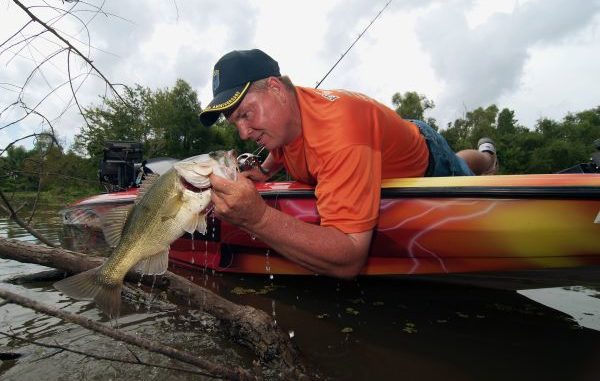
14-inch size limit doesn’t grow big bass, Louisiana Department of Wildlife & Fisheries says.
For just about the entire time Brent Bonadona has been fishing the Atchafalaya Basin, there has been a 14-inch minimum length limit on bass coming from the area. And for the most part, Bonadona has been pleased with the results of that regulation, which was put in place shortly after Hurricane Andrew ravaged Southcentral Louisiana in 1992.
Bonadona has seen steady catches of decent heft during the past two decades. He’s seen subsequent tropical systems disrupt the fishery, (systems that killed millions of fish,) and he’s seen the resurgence of the Basin time after time in the wake of storms.
So it’s not surprising that Bonadona favors keeping the 14-inch minimum length limit in the Atchafalaya Basin and adjacent waters.
“I like the (14-inch) limit,” he said. “I think we’ve seen some results from it. We’ve seen several 9- and 10-pounders come from the Basin, especially from the lower end. And I think it was last year we saw a record stringer in a Spillway tournament.”
Trouble is that the Louisiana Department of Wildlife & Fisheries released a technical report on the Basin in ear;y October that states the regulation does not produce larger bass.
So after 20 years of following the 14-inch rule, the report that’s sure to make some Atchafalaya anglers scratch their heads.
The details were laid out in an open letter to Atchafalaya Basin sportsmen by Mike Wood, the LDWF director of Inland Fisheries. In that letter, and the 10-page report that came with it, LDWF officials say results “indicate that the Basin bass population is more heavily influenced by environmental factors than anglers.” Spring water fluctuations, as well as storms and drought, play a pivotal role in the quality of the population, while slow growth and a shorter than average lifespan for the Basin’s bass seem to be inherent, the study shows.
Wood said when Hurricane Andrew made landfall in 1992 there wasn’t much scientific knowledge on the growth and mortality of Atchafalaya Basin bass, or bass in general, in the state.
“You have to remember that our specific bass management program was young at the time,” he told Louisiana Sportsman. “It only started in 1991, a year before Andrew hit. So we didn’t have a lot of long-term data to go off of. (The 14-inch size minimum) seemed valid in the short term to manage it, but it was shanghaied.
“It was not our original intent (to make the Basin a big-bass fishery.)”
Now that there’s 20 years of data to use as a guide, Wood wrote in the open letter that “many Basin anglers began to question the logic of releasing bass only to see them become the victims of the next big storm. The regulations began to lose much of the public support that had helped transform them from a temporary protective measure into a long-term regulation.
Wood said, however, that a survey conducted last year with Basin anglers said people “by a margin were OK with the regulation” as it is. He questioned the results of the survey, though.
“If I put myself in their shoes, I think the fishery is being protected because the biologists are doing their jobs,” he said. “I would have to assume that people were for it on that basis. But like I said, in this case, it was shanghaied. (The regulation) was taken out of its intent.”
Perhaps the most-surprising finding in the LDWF study was the slower growth rate and a higher mortality rate for Atchafalaya Basin bass. The report found that the 2011 sample of fish showed a 73-percent mortality rate, which was attributed strongly to tropical storms and droughts.
The growth rate is a result of diet, Wood said.
“Basin bass feed most often on crawfish, (as opposed to) other areas where they feed on other fish,” he said. “The crawfish are high in carbs. It’s sort of like candy. They just don’t grow as fast there.”
Bonadona, for his part, would like to see extra effort put into protecting and even regulating bass in the Basin. In particular, he would like for additional dredges to improve water flow from area rivers — spots where bigger bass congregate, along with baitfish and crawfish.
And he fears removing the regulation could be damaging.
“I think if you remove it, then you start to wipe out the population pretty quickly, unless there is some sort of progressive restocking,” Bonadona said. “There’s a lot of money made in tax dollars because of fishing, especially in South Louisiana. Ideally, I’d like to see more money put into it.”
Wood respectfully disagrees with the idea of possibly decimating the number of bass by dropping the 14-inch minimum.
“We’re long past any potential benefits (the length regulation provided),” he said.
He added, however, that the LDWF has no intention of removing the regulation without first hearing from the public. He encourages all anglers in the Basin area to make themselves familiar with the full report.
Click here to read the full report.
Within one or two months, Wood said his agency will seek input via another survey of Basin anglers. That’s where the real discussion will begin, he said.
“It’s important to get this information out to the people,” he said. “We’ll ask if they’re OK with the regulations. There may be some reason why they want the regulations to continue. We want to know what they want.
“After all, they’re the people that make it work.”